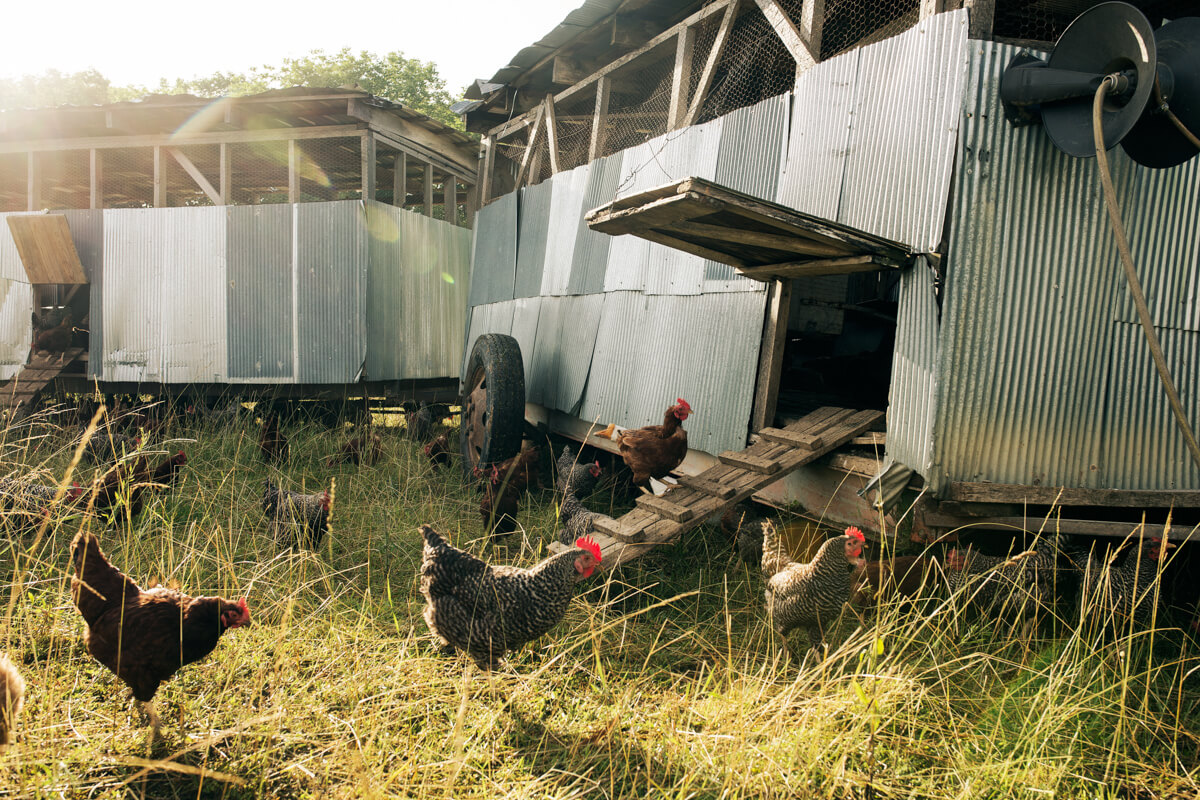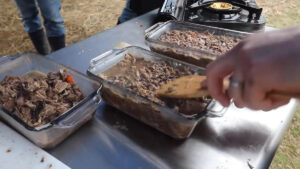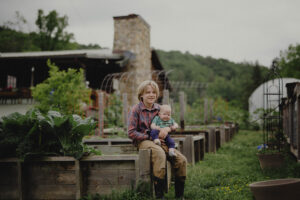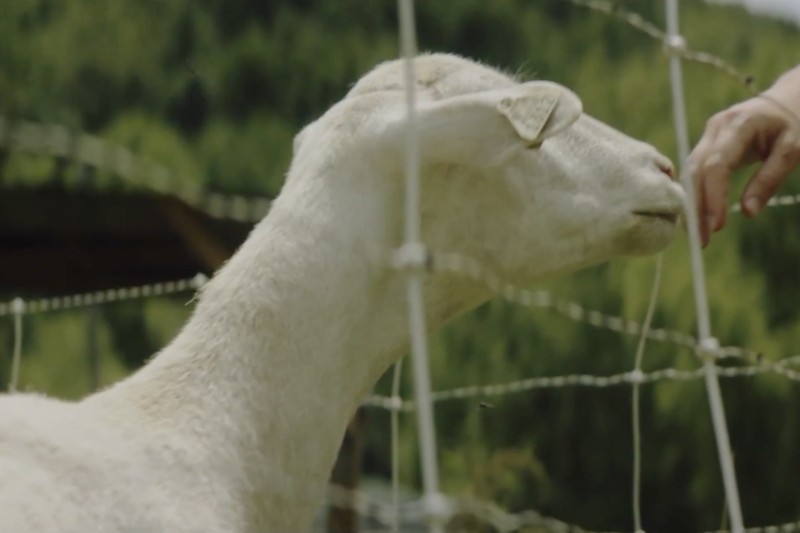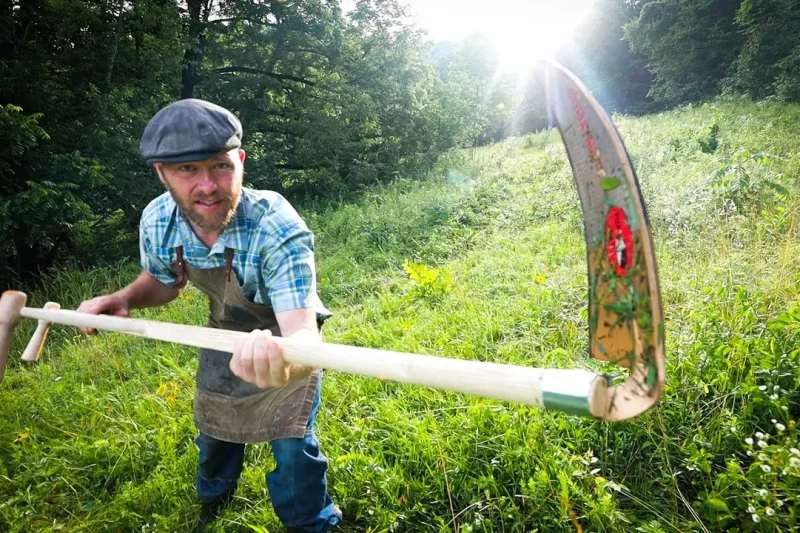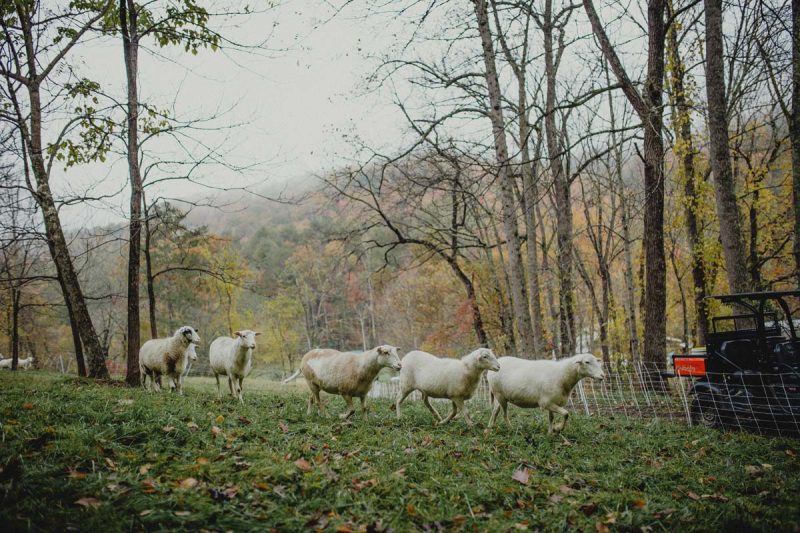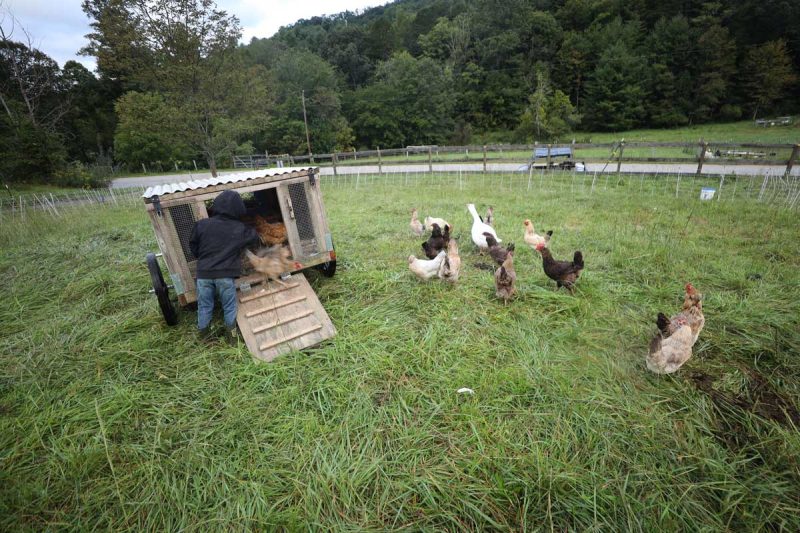I want to share some great chicken coop ideas so you can design and build an easy, small shelter for your chickens, complete with a chicken run and door to keep them safe inside.
Many free chicken coop plans are available, but there are also many factors to consider when deciding on the best one for you and your homestead.
Chicken Coop Ideas and How to Make Them Work
Some of these DIY chicken coop plans will result in a large chicken coop, while others will be built as a small chicken coop.
I’m going to share some of my experiences with the various hen houses, as well as give you some advantages and disadvantages of each plan.
I’m not including detailed instructions on building a chicken coop (although I link a few). They are all easy to build, but follow the link or find a building plan that resembles the chicken coop idea I describe for step-by-step instructions and material lists.

Idea # 1 – Chicken Tractors
A chicken tractor is a small, movable chicken house without a floor. It’s called a tractor because of its ability to put the chickens to work.
The tractor can be sized according to its duty. Sometimes they are sized to house a certain amount of chickens, while other times, they are sized to fit over a specified area such as a garden bed.
I make my chicken tractors 40” x 10’ as that is the size of the garden beds where I’ll be using my tractors.
The capacity for the number of chickens to the size of the tractor should be at least one and a half square feet per chicken if used for meat birds and three square feet if used for egg layers.
Advantages
- Easy to use
- Small and lightweight
- Inexpensive to build or acquire
- A great way to fertilize a yard or garden bed
- Till your garden beds to prepare for planting or clean up spent produce
- Great for small yards and gardens
- Can be moved daily to offer fresh forage
- May be used as a day shelter for day jobs or as permanent housing
Disadvantages
The disadvantages are almost non-existent on this one. They are small. If you have large birds in there full time, I recommend only three or four birds per chicken tractor. If it’s just their hotel, you can easily fit in twelve birds.
My Experience with the Chicken Tractor
I use my chicken tractor all summer as a hotel for my breeding flock. I set my small flock of eight chickens in my kitchen garden area.

Idea # 2 – Pastured Poultry Pen
This is a larger, movable tractor of approximately 10’ x 10’ x 2’. These pens are designed to be moved at least once daily, giving the chickens fresh grass. Because of this frequent moving, you can give them less square footage per chicken than a static coop.
Advantages
- An easy and affordable way to get started with a large number of chickens
- Usually heavy enough to withstand winds and predators
- Can be moved by just one person
- Scale up by simply creating more
- It can serve many different purposes, such as raising broilers (meat chickens), pullets (young laying chickens before they’re old enough to lay eggs), mama hens with chicks, or permanent housing for a small flock.
Disadvantages
- Larger numbers of chickens per pen can nearly decimate the ground in one day.
- It can be heavy to move without a specially welded dolly. I’ve had to move mine by dragging. I even lined the bottom with PVC, but moving it is still quite a pull.
- You can run over chicks and kill or injure them if you’re not careful.
My Experience with a Pastured Poultry Pen
This has been a well-rounded setup on my farm. I’ve used this for broilers, housing layer birds, isolated chickens, and chicks.
My favorite use for this pen is allowing a mama hen to raise her chicks. Hawks are a major problem on our farm and will prey on the young chicks even under the watchful eye of the mama hen. This keeps them in a safe, contained area.
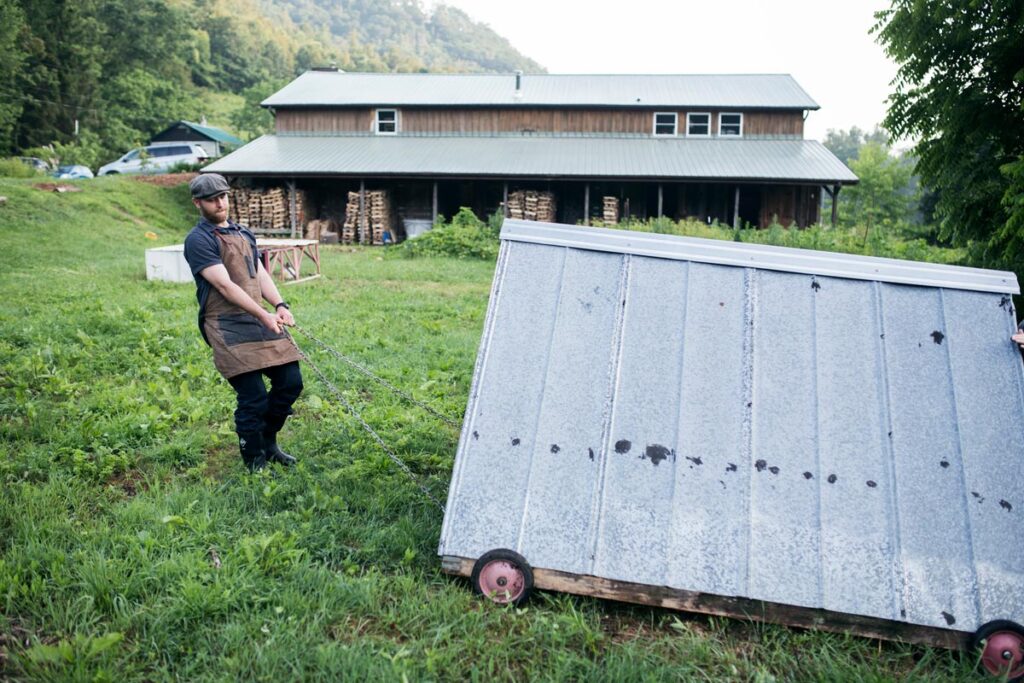
Idea # 3 – Mobile Chicken Coops
The name says it all for this type of design. Mobile coops can vary in size. I’ve used Harvey Ussery’s A-frame design for years (it houses about 30 chickens). Some folks, like Geoff Lawton, convert small trailer frames into coops, while Joel Salatin is famous for his large egg mobiles.
I’ve designed and built on a relatively new concept: the Chickshaw, ChickShaw 2.0 and ChickShaw MiniMe. What sets the Chickshaw apart from other designs is that it can hold up to three dozen chickens and still be light enough for one man (or woman) to move the coop long distances through relatively treacherous territory.
With this kind of operation, chickens will have plenty of access to the outdoors during the day, so one square foot of space per chicken should suffice.
A mobile chicken coop enables you to offer your chickens a new “salad bar” whenever the coop is moved while maintaining familiarity for the chickens.
Advantages
- Offers chickens fresh food when the coop is moved.
- The coop is home, so the chickens naturally center their lives around it no matter where it ends up.
- Moving to new ground can create a significant amount of food for the chickens in the coop.
- No manure cleanup as it falls on the ground.
Disadvantages
- If you’re free-ranging with no electric net fencing, you’ll need significant acreage – approximately 40 acres. Otherwise, your chickens will become familiar with certain areas like the shade by the creek, and they’ll loiter there.
- Large coops must be moved with a vehicle or tractor.
My Experience with Mobile Chicken Coops
I’m operating at a smaller homestead level, meaning I have between two to three dozen chickens at any time. It’s necessary that my mobile chicken houses can be moved by manpower.
I’ve used Ussery’s A-frame design for years and find it quite useful when I don’t need to move the coop long distances or over rough terrain. The A-frame is great for year-round permanent housing.
Because it doesn’t have a floor, it can be used as a chicken tractor. However, it’s so heavy and has such a low center of gravity that it’s not great for moving around in the pasture.
I’ve created my Chickshaw, which is lighter than the A-frame, and the floor serves as the perches and allows night manure to drop through.
The large, pneumatic wheels (26”) allow easier movement over further and more tortuous distances. The tall wheels also allow for the chickens to seek shelter under the “shaw” during the day.
The Chickshaw can hold up to 36 chickens and can still be moved by one person. In addition, the manure falls through the housing floor directly to the pasture floor or a bed of carbon.
Idea # 4 – Greenhouses
A greenhouse is a winter-season option for cold climates. You can easily convert a greenhouse into a chicken coop by boarding up at least two feet of the sides to hold in deep bedding and by adding a four-foot fence to protect the plastic.
Add about one foot of carbon material such as wood chips or leaves to absorb the manure. This amount of carbon should be good for about one hundred days at three square feet per chicken.
Feed the chickens by dribbling the food directly onto your carbon material. This encourages your chickens to scratch and stir the material, keeping the manure well circulated. Some of the lost seeds will warm up and sprout and add value when found.
Joel Salatin adds young pigs and rabbits to the greenhouse mix. He hangs the rabbit cages off to the side where their manure drops down to the carbon. He then creates a level in the middle that only the chickens can get to, so the pigs don’t get the chicken food. He feeds the pigs directly.
The pigs do a great job tilling the hard wet spots that the chickens can’t work in. Use hog panels and electric netting to keep the chickens and pigs off the plastic.
As a bonus, grow veggies in the bedding when the animals go out!
Advantages
- Keeps chickens warmer during the cold months.
- Creates a good growing medium for spring greenhouse crops.
- If your greenhouse is next to your garden, you can give the chickens an outdoor run on deep bedding over your garden.
Disadvantages
- Takes up greenhouse space that could have been used for plants.
- If you don’t plant in the greenhouse in the spring, you’ll need to muck out the compost material.
- It may be hard for you to acquire that much carbon material.
- If you don’t use pigs, you’ll have to physically loosen some of the wet and harder spots for the chickens.
My Experience
Several years ago, I opted to house a small flock of chickens in a small 10’ x 15’ greenhouse. I lined the sides with a two-foot wooden wall to hold in about a foot of wood shavings for deep bedding.
I grabbed an old bookshelf and added some boards to the front of the shelves to hold in nesting material. I mounted a four-foot fence made of chicken wire to keep the chickens from jumping over the wooden wall or pecking the greenhouse plastic.
The result? My chickens loved it!
In addition, they were more productive, and I had a greater egg collection than in previous winters. I distinctly remember how bright, lively, and warm it felt in the house all winter.
At the time, I was picking up organic produce waste from the local co-op grocery store, so I’d throw those food scraps directly on top of the deep bedding to get consumed or mixed into the composting material.
The greenhouse was unheated, so it still got cold at night. However, the chickens had each other for warmth, and the greenhouse protected them from wind and rain.
There were many single-digit nights, and everyone did just fine. Looking back, I would have added more ventilation on the top sides of the greenhouse and an outdoor run topped with lots of carbon material that could serve as an outdoor garden once the chickens were removed.
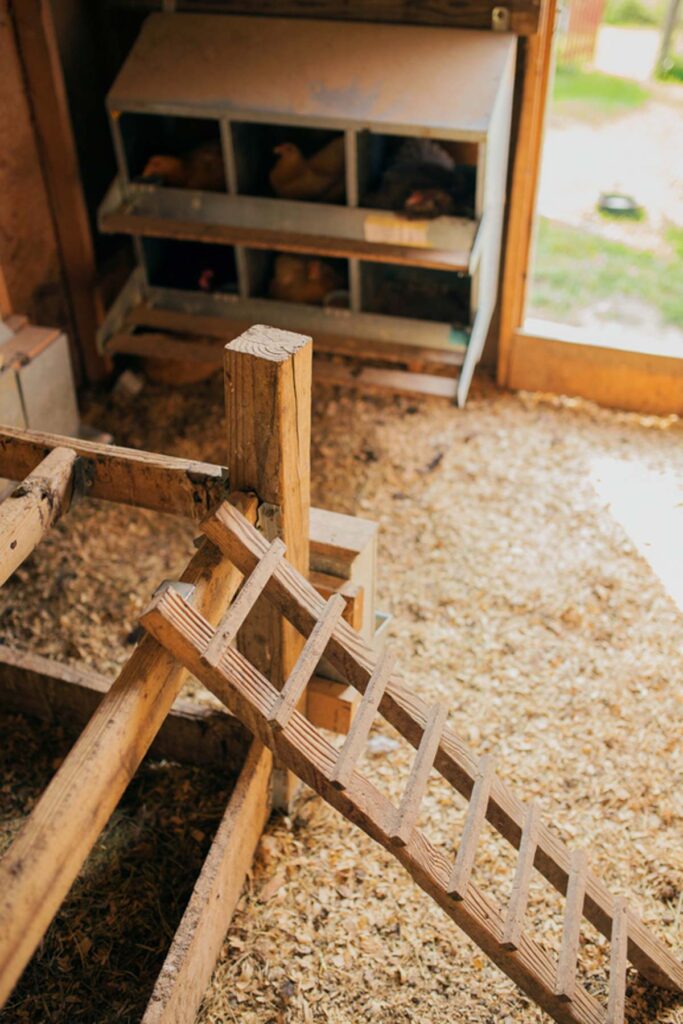
Idea # 5 – Coop and Run
Most chicken keepers like to use the static coop and run method, but it’s probably the most unproductive housing system I’ve mentioned.
In a coop and run situation, neither the coop nor the run is mobile. In many of these situations, the housing has a floor, and the owner has to muck out the manure regularly.
If the run is left bare, then all vegetation is soon depleted. The soil becomes contaminated with too much manure, and precious run-off of valuable manure and topsoil can occur.
In addition, a bare chicken yard can be quite unattractive, smelly, and tricky to walk through.
If moving your chickens’ housing isn’t an option, you might consider rotating a mobile chicken fence around the housing.
For example, you could have four doors near each corner and rotate your chicken through four temporary yards, giving each paddock time to rest.
You might also consider two fences next to the housing one is for a garden, and the other is for the chickens. In this case, let one area be your garden for one year, let the second area be for your chickens, and then switch it the following year.
If you can’t have more than one house and one run, you can still get some significant work done by simply adding organic matter! Add at least eight inches of high-carbon material like leaves, wood chips, and straw.
As the chickens scratch and fertilize, the bottom layers will become compost. After several months, you can begin harvesting the compost from the bottom of the run and just add more material as you go.
My Experience with Coop and Run
Due to some health issues, I kept my chickens in a static coop and run last year. I live in a horse ranch barn, so I converted one of the downstairs horse stalls into a coop for my chickens.
I used an electric net for their “permanent” fencing. During this time, I implemented a compost system that provided 100% of all my flock’s food needs and gave me one cubic yard of compost a week!
More Posts You May Enjoy
- How to Care for Baby Chicks
- Using the Permaculture Approach for Your Chicken Flock
- Backyard Chickens – How to Get Started
- How to Butcher a Chicken
- Five Stages for Success With Breeding Chickens
- Feeding Chickens Without Grain – Cut Your Costs 100%
- Best Herbs for Chickens – How to “Herbify” Your Chickens Like Lisa Steele
- What Killed My Chicken? – How to Know

